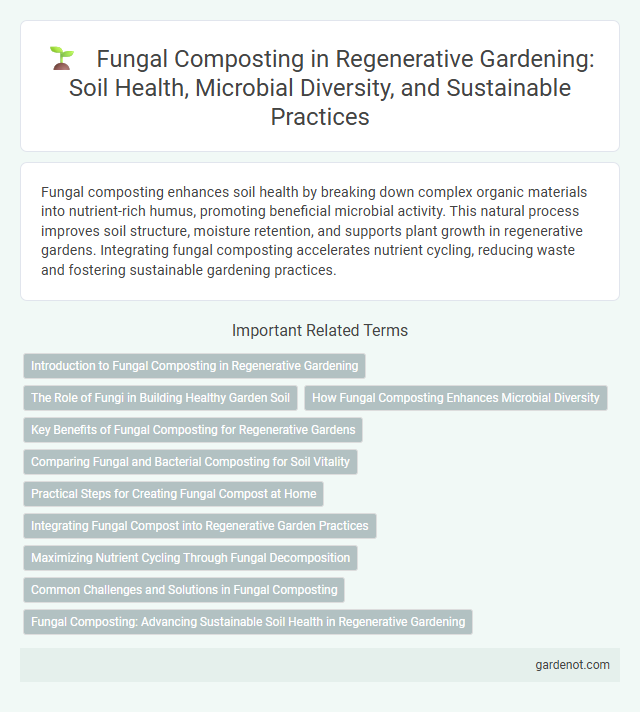Fungal composting enhances soil health by breaking down complex organic materials into nutrient-rich humus, promoting beneficial microbial activity. This natural process improves soil structure, moisture retention, and supports plant growth in regenerative gardens. Integrating fungal composting accelerates nutrient cycling, reducing waste and fostering sustainable gardening practices.
Introduction to Fungal Composting in Regenerative Gardening
Fungal composting plays a crucial role in regenerative gardening by accelerating organic matter decomposition through the activity of beneficial fungi such as Trichoderma and mycorrhizal species. These fungi break down complex cellulose and lignin in plant materials, enriching soil structure and nutrient availability, which supports robust plant growth and resilience. Integrating fungal composting enhances soil biodiversity and carbon sequestration, key components in sustainable and regenerative agricultural practices.
The Role of Fungi in Building Healthy Garden Soil
Fungi play a critical role in building healthy garden soil by breaking down organic matter into nutrient-rich humus, which improves soil structure and fertility. Mycorrhizal fungi form symbiotic relationships with plant roots, enhancing nutrient and water uptake essential for plant growth. Incorporating fungal composting in regenerative gardens supports soil biodiversity and resilience, leading to sustainable and productive ecosystems.
How Fungal Composting Enhances Microbial Diversity
Fungal composting significantly enhances microbial diversity by fostering a complex ecosystem where fungi decompose organic matter into nutrient-rich humus, creating an ideal habitat for diverse microbial communities. The mycelium network breaks down tough plant fibers, releasing sugars and nutrients that support beneficial bacteria, actinomycetes, and other microorganisms vital for soil health. This increased microbial diversity improves nutrient cycling, soil structure, and disease resistance in regenerative gardens.
Key Benefits of Fungal Composting for Regenerative Gardens
Fungal composting enhances soil structure and nutrient availability by breaking down complex organic matter into humus-rich compost, promoting healthier plant growth in regenerative gardens. It fosters a diverse microbial ecosystem that improves soil aeration, water retention, and disease resistance, leading to increased garden resilience. The synergistic activity of fungi in composting supports carbon sequestration, contributing to sustainable soil regeneration and climate mitigation efforts.
Comparing Fungal and Bacterial Composting for Soil Vitality
Fungal composting enhances soil vitality by breaking down complex organic materials like lignin and cellulose, creating nutrient-rich humus that promotes robust plant growth. In contrast, bacterial composting rapidly decomposes simple organic matter but often results in faster nutrient cycling with less stable soil structure. Emphasizing fungal activity in regenerative gardens leads to improved soil aeration, moisture retention, and long-term fertility compared to primarily bacterial composting methods.
Practical Steps for Creating Fungal Compost at Home
Creating fungal compost at home involves layering organic materials such as shredded leaves, wood chips, and coffee grounds to encourage fungal growth. Maintaining a moist, aerated environment supports the beneficial fungi that break down tough cellulose and lignin in plant matter. Regularly turning the pile and adding mushroom spawn can accelerate decomposition and enhance nutrient-rich compost production.
Integrating Fungal Compost into Regenerative Garden Practices
Integrating fungal compost into regenerative garden practices enriches soil biodiversity by promoting beneficial mycelium networks that enhance nutrient cycling and water retention. The decomposition process driven by fungi breaks down complex organic matter, improving soil structure and fertility essential for plant health and resilience. Regular application of fungal-enriched compost supports sustainable ecosystem functions, reduces waste, and fosters a self-sustaining garden environment.
Maximizing Nutrient Cycling Through Fungal Decomposition
Fungal composting enhances nutrient cycling by breaking down complex organic matter such as lignin and cellulose into bioavailable forms, enriching soil fertility and structure. Mycelium networks facilitate the decomposition process, releasing essential nutrients like nitrogen, phosphorus, and potassium while promoting microbial diversity in regenerative gardens. This efficient nutrient turnover supports plant growth and soil health, driving sustainable ecosystem regeneration.
Common Challenges and Solutions in Fungal Composting
Fungal composting often faces challenges such as maintaining optimal moisture levels, temperature control, and preventing contamination from competing microorganisms. Effective solutions include regular monitoring of moisture content between 50-60%, ensuring temperatures remain within the ideal 25-30degC range for fungal growth, and sterilizing or pasteurizing the composting material to reduce unwanted bacteria. Incorporating lignocellulosic materials like straw or wood chips promotes fungal colonization and enhances compost quality by improving aeration and nutrient balance.
Fungal Composting: Advancing Sustainable Soil Health in Regenerative Gardening
Fungal composting enhances soil structure and nutrient cycling by breaking down complex organic matter into bioavailable compounds essential for plant growth in regenerative gardening. The mycelium networks formed through fungal activity improve soil aeration, water retention, and microbial diversity, fostering a resilient ecosystem that supports sustainable agriculture. Incorporating fungal composting accelerates organic waste decomposition while promoting soil carbon sequestration, a vital process in combating climate change and restoring degraded soils.
Fungal composting Infographic

 gardenot.com
gardenot.com